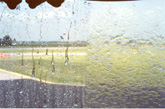7) Role of roughness as an amplifier
The surface roughness (r) has a considerable influence on both the contact angle itself and its hysteresis. In preceding section we discussed that roughness of surfaces can lead to contact angle hysteresis. In addition, it influences the mean contact angle. An important aspect is the length scale involved. For not too rough surfaces (roughness significantly below the wavelength of light) we can describe the effect of surface roughness by the so-called Wenzel equation. The equation predicts that if a molecularly hydrophobic surface is rough, the appearance is that of an even more hydrophobic surface. If a hydrophilic surface is roughened it becomes more hydrophilic. Click here to find detailed information.
Most solid surface are also chemically inhomogeneous. Cassie considered a smooth but chemically patch wise heterogeneous surface. If there are two different kinds of region with contact angle θ1 and θ2, which occupy the surface ratios f1 and f2 the apparent average contact angle is cosθapp = f1cosθ1+ f2cosθ2. Click here to find detailed information.
(i) Roughness amplifies non-wettability
If we take water as a liquid, hydrophobic solids such as waxes have interesting properties, but the contact angle does not generally exceed 120°. The trick to reach super-hydrophobic states consists of achieving rough (or textured) hydrophobic solids. Then, because the liquid doesn't enter inside the roughness, a drop sits on a patchwork of solid and air, which leads to contact angles typically between 165° and 175°. More interestingly, this effect is also characterized by a very low contact angle hysteresis (Δ θ < 10°), because the air trapped below the drop "homogenizes" the solid.
| Water drop on a hydrophobic surface decorated with spikes (Bico et al. Europhysics Letters 47(2) 220-226) |
Practical consequences
-Super hydrophobic windshields
Because of super-hydrophobicity water won't stick to the windshield giving rise
to clean surfaces. If the spatial scale of the roughness is small compared to
the wavelength of light the texture does not affect optical transparency.
Click here to find more about the commercialized product based on this idea.

| Water droplets bead and roll off coated glass (left) for enhanced visibility during rain conditions compared with uncoated glass (right). |
-Fastskin
http://www.kennislink.nl/ | Combined effects of roughness and hydrophobicity have been found to induce significant drag reduction for flow past these surfaces. One of the useful products based on this idea is Fastskin, which helps swimmers swim fast. |
-The Lotus effect
| Combined effects of roughness and hydrophobicity results in self-cleaning surfaces. Nature has the best example- a lotus leaf. A droplet takes up the particles loosely covering the leave while rolling off, thus cleaning the surface. Click here to find a nice discussion and more pictures. |
-Calphalon frying pans
Back to index ||Introduction to surface tension ||Definition of surface tension||Interfacial tension ||Minimal surfaces ||Soap bubbles, Surfactants and Detergents
Wettability||Role of roughness ||Capillarity and gravity||Dynamical effects and instability||Special interfaces ||Current research in wettability
Back to NIRT Home||On our current research ||More on Wetting||Contact Angle Measurement||Atomic Force Microscopy ||My personal homepage